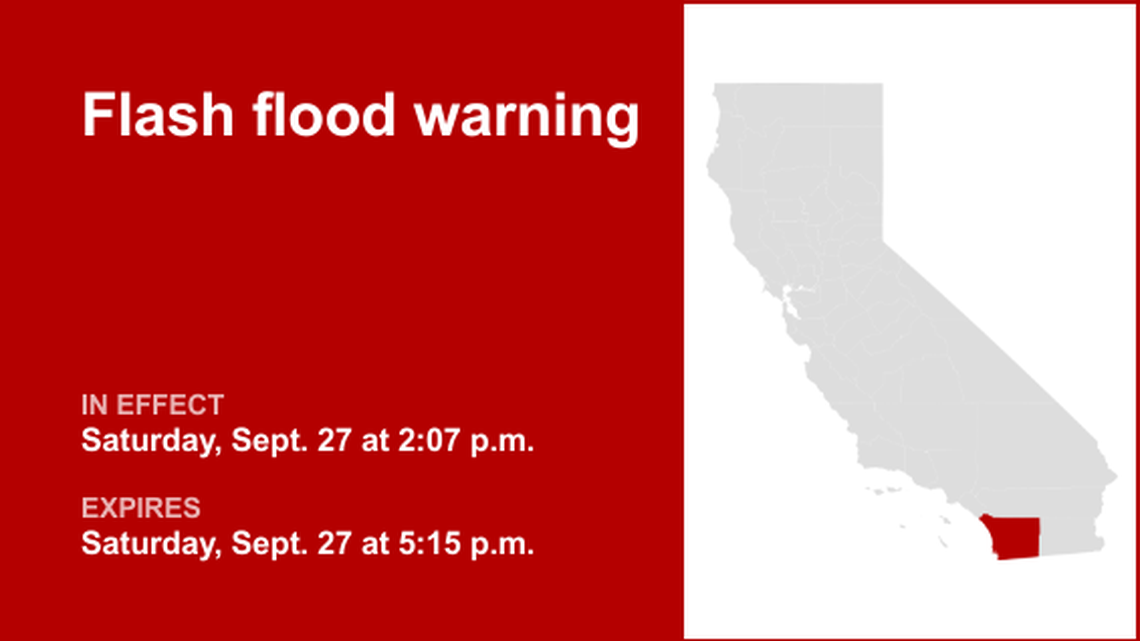UPDATE: The flash flood warning for San Diego County is predicted to expire at 5:15 p.m.
Warganet – The creation of this content included the use of AI based on templates created, reviewed and edited by journalists in the newsroom. Read more on our AI policy here.
The warning was issued for San Diego County.
“Flood waters have receded. The heavy rain has ended. Flooding is no longer expected to pose a threat. Please continue to heed remaining road closures. A Flood Watch remains in effect until 7 p.m. for a portion of Southwest California. A Flood Watch remains in effect until 7 p.m. for a portion of Southwest California,” according to the NWS San Diego CA.
The warning is in effect until 5:15 p.m.
Ways to stay safe during a flood according to the NWS
For either residents or campers of flood-prone, low-lying areas, take immediate action and seek higher ground. Follow evacuation instructions without delay. If time permits, lock your home upon departure and disconnect utilities and appliances. Avoid entering basements or rooms where electrical outlets or cords are submerged in water. If you see sparks or hear buzzing, crackling, snapping, or popping sounds, evacuate the area immediately. Refrain from entering water that may have electricity in it and avoid walking through floodwaters. Even 6 inches of moving water can pose a serious risk of knocking you off your feet. If you find yourself trapped by moving water, move to the highest possible point and contact emergency services, and dial 911.
During periods of intense rainfall, the risk of flooding increases, particularly in low-lying and flood-prone areas. It is imperative to avoid driving through any water on the road, even if it seems shallow. According to the NWS, most cars can be swept away by just 12 inches of rushing water.
What to do in the rain on the road?
- Turn on your headlights – Even when it’s light outside, using headlights can improve visibility and alert other drivers to your presence.
- While driving – Stick to the middle lanes and stay on elevated ground. Rainwater tends to accumulate at the road edges.
- Avoid puddles – Driving into puddles or low rainwater areas can lead to vehicles hydroplaning or losing control.
- Maintain a safe distance from large vehicles – Trucks or buses can produce a water spray that hampers visibility.
- Steer clear of flooded areas – When coming to a flooded road, turn around and head back. Flash flooding currents are strong and can sweep drivers off roadways. Driving through deep water can also affect a vehicle’s mechanical and electrical systems.
What is hydroplaning?
Hydroplaning is the term for when a vehicle begins sliding uncontrollably on wet roads.
This happens when water in front of the tire builds up faster than the vehicle’s weight can push water out of the way. The water pressure then causes the vehicle to rise and slide on a thin layer of water between the tires and the road, making the driver lose control. Hydroplaning is primarily caused by three factors:
- Vehicle speed – When a vehicle’s speed increases, the tire-traction grip and ability to control the vehicle decreases. Drive at a reduced speed during wet weather.
- Water depth – The deeper the water, the sooner a vehicle loses traction on the road. It doesn’t matter how deep the water is, even a thin layer can lead to hydroplaning.
- Tire tread depth – Checking your tire tread before hitting the road is important, as low or no tread can lead to sliding.
In the event of your vehicle hydroplaning, here’s what to know:
- Ease off the accelerator – Step off the gas to slow down the vehicle until the tires find traction.
- Turn into the skid – Turning into the skid can help the vehicle’s tires realign to regain control.
- Make sure the tires reconnect with the road – During the skid, wait until the tires reconnect with the road and then gently straighten the wheels to regain control.
- Brake gently as needed – Brake normally if the vehicle has anti-lock brakes and pump brakes gently if in an older vehicle. (*)
Source: The National Weather Service













